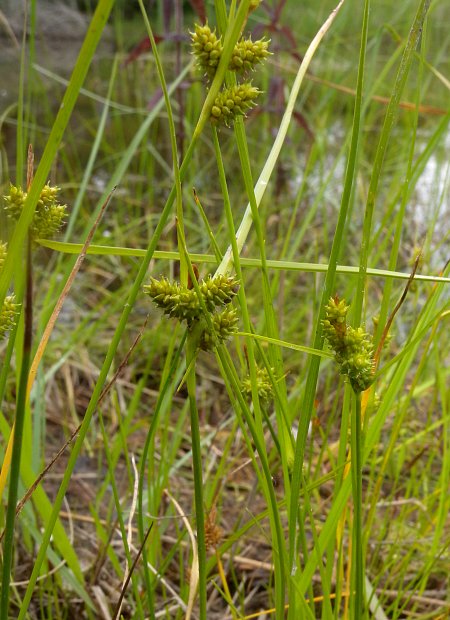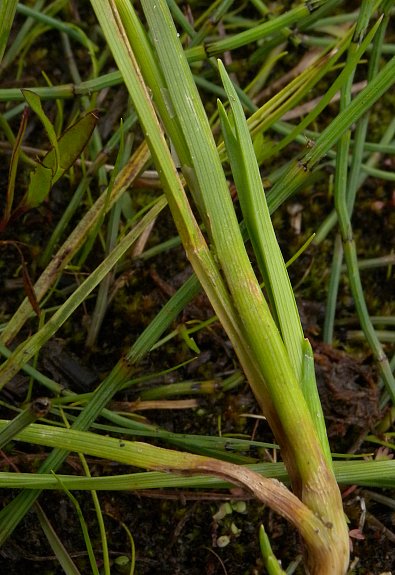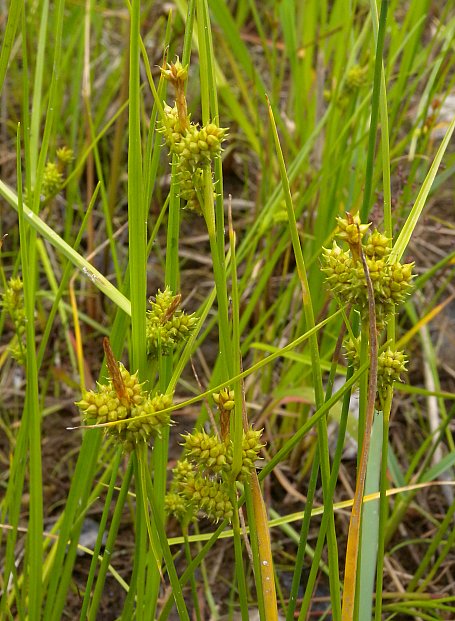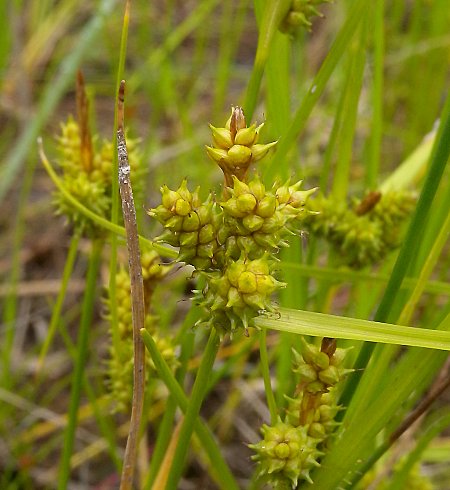
The pistillate spikelets are 5-12 mm. long, 4-5 mm. across, and light green to yellow; they are short-cylindrical to nearly globoid in shape and prickly in appearance because of the short beaks of the perigynia pointing in all directions. At the bases of lower pistillate spikelets or their peduncles (basal stalks), there are solitary leafy bracts up to 5" long and 3 mm. across; they are similar to the alternate leaves below. The terminal spikelet, when it is staminate, is about 6-8 mm. long, yellowish brown to brown, and narrow; when the terminate spikelet is gynecandrous, it is about the same length, although wider where the perigynia occur. The perigynia (sacs surrounding the achenes) are 2-3 mm. long and about 1.5 mm. across; they are light green to yellow, glabrous, vertically veined, bluntly 3-angled, and ovoid-obovoid to obovoid in shape with a narrow straight beak (about 0.5 mm. in length) above. The pistillate scales are a little shorter than the perigynia and ovate-obovate to obovate in shape; they are green-veined in the middle, otherwise membranous, becoming brown or reddish brown with age. The blooming period can occur from late spring to mid-summer, lasting 1-2 weeks for each plant. Cross-pollination of the florets is by wind. Afterwards, the achenes become mature about 1 month later. Mature achenes are 1.0–1.25 mm. long, 0.75–1.0 across, obovoid and bluntly 3-angled in shape, glabrous, and brown to black. The root system is fibrous and short-rhizomatous.

Cultivation: The preference is full or partial sun, wet to moist conditions, and a rather barren soil containing sand or gravel. Because this is a boreal sedge, it is not well-adapted to hot dry weather.
Range & Habitat: Little Green Sedge occurs in NE Illinois, where it is native, rare, and state-listed as 'threatened' (see Distribution Map). Illinois lies along the southern range-limit of this species. This sedge has a wide distribution in boreal areas of North America; it also occurs in Eurasia. Only the typical subspecies of this sedge, Carex viridula viridula, is found in Illinois. Habitats include sandy shores of small ponds, interdunal swales along Lake Michigan, pannes (moist sand flats) along Lake Michigan, seeps, fens, sandy marshes, and poorly drained flat gravelly areas. In Illinois, this sedge is found in high quality natural areas.

Faunal Associations: Insects that feed on wetland sedges (Carex spp.) include leaf beetles (Plateumaris spp.), billbugs (Sphenophorus spp.), larvae of leaf-miner flies (Cerodontha spp.), seed bugs (Cymus angustatus, Oedancala dorsalis), plant bugs (Mimoceps insignis, Teratocoris discolor), aphids (Allaphis spp., Iziphya spp., Rhopalosiphum spp., Subsaltuaphis spp.), leafhoppers (Cosmotettix spp.), sedge grasshoppers (Stethophyma spp.), larvae of the Tufted Sedge Moth (Hypocoena inquinata) and other moths, larvae of skippers (Euphyes spp., Poanes spp.), and larvae of two butterflies, Appalachian Brown (Satyrodes appalachia) and Eyed Brown (Satyrodes eurydice); see Clark et al. (2004), Vaurie (1983), Spencer & Steyskal (1986), Hoffman (1996), Marshall (2006), Knight (1941), Hottes & Frison (1931), Blackman & Eastop (2013), Panzer et al. (2006), Capinera et al. (2004), and Bouseman et al. (2006). An aphid, Iziphya americana, has been observed to feed on the Little Green Sedge (Carex viridula). The seeds or seedheads of wetland sedges are a source of food for many birds, including ducks, rails, some songbirds, and others. The Bird Table lists some of these species. The Canada Goose also feeds on the leaves of these plants. White-tailed Deer browse on the leaves and seedheads to a limited extent – the seeds of sedges are able to pass through the digestive tract of this animal and remain viable (Myers et al., 2004). This helps to spread the seeds to new locations. Muskrats feed on the rhizomes and culms of sedges to a limited extent (Hamerstrom & Blake, 1939), while some turtles, like the Snapping Turtle and Easter Mud Turtle, eat the seedheads sparingly (Ernst et al., 1994).
Photographic Location: Sandy shore of a small pond and a moist sand flat along Lake Michigan at the Illinois Beach State Park in NE Illinois.

Comments: The Little Green Sedge (Carex viridula) is one of the smaller wetland sedges. Its leaf blades are up to 3.5 mm. across, its perigynia are 2-3 mm. long, and the beaks of its perigynia are about one-fourth as long as their bodies. It is most similar to two other sedges that are found in NE Illinois; they are also rare. These two species are Northeastern Sedge (Carex cryptolepis) and Yellow Sedge (Carex flava). Compared to the Little Green Sedge, Northeastern Sedge has larger perigynia (3.0–4.5 mm. long), and the beaks of its perigynia are proportionately longer (about one-half the length of their bodies); the leaf blades of this sedge also tend to be slightly wider (up to 4.5 mm. across). Similarly, Yellow Sedge has even larger perigynia (4.0–6.0 mm. long), and the beaks of its perigynia are also proportionately longer (about the same length as their bodies). In addition, the leaf blades of this last sedge are substantially wider (up to 6.5 mm. across) than those of the Little Green Sedge. Another species, Hale's Sedge (Carex haleana), has perigynia that are similar in size to those of the Little Green Sedge, but they lack significant beaks. As a result, the female (pistillate) spikelets of Hale's Sedge have a grainy appearance, rather than a prickly one. This sedge also has much wider leaf blades (up to 10 mm. across). A discussion of these and other technical differences between these sedges can be found in Mohlenbrock (2011), especially on p. 411.